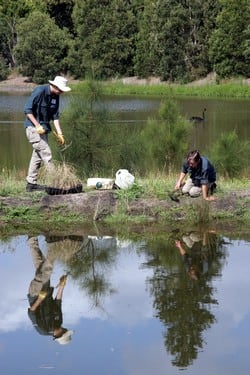While the Parklands may be mainly characterised as a cultural landscape developed over several generations, it nonetheless plays a significant role in the environmental health of Sydney, particularly as a filter for stormwater over a wider urban catchment and as a refuge for native fauna.
Pressures on the Parklands
There are numerous challenges that the Trust must plan for in order to sustain these Parklands, including:
- continuing increases in surrounding population and population densities, with subsequent demand on the Parklands' facilities and environment zones
- intensifying urban development, particularly hard surfaces in the catchment, that increase urban runoff with polluted stormwater leading to pressures on the Parklands' ponds and aquifer
- loss of habitats in the region owing to urbanization, increasing the importance of the Parklands as an island refuge for native flora and fauna
- increasing car use affecting air quality in the locality
- absence of connected vegetation corridors in the locality leading to isolation of remnant habitat in the Parklands such as the Eastern Suburbs Banksia Scrub fragments, limiting native fauna movement and reducing opportunity for recharge of native seed banks from external sources.
- conducting its own maintenance operations in a way which doesn’t degrade the environment In a broader context, greater unpredictability in climate, leading to increased frequency and severity of storms, droughts and floods also place the interrupted ecology of the Parklands under stress.
Addressing the pressures
 Many of the pressures on the Parklands outlined above are matters over which the Trust may have no direct control or influence.
Many of the pressures on the Parklands outlined above are matters over which the Trust may have no direct control or influence.
Nevertheless, the Trust aims to address such pressures by adapting to its operating environment, and seeking to influence external decision makers constructively where it can.
Importantly, the Trust also seeks to ensure that the core values of the Parklands are not compromised whatever the external pressure.
This is a complex balancing act, and will continue to be a challenging task. The basis for management is set out in the Trust's Plan of Management 2006-2016.
The Trust has carried out a successful restoration program on its two ESBS sites, which are now regarded as best-practice examples of urban bushland restoration.
The Trust has also continued to plant locally endemic species in its pond restoration program, to provide vegetation refuges for native birds, and has continued to eradicate pest species which impact on the viability of native flora and fauna.
A significant victory has been the elimination of European Rabbits which cause erosion and loss of vegetation, and also the continued control of a range of invasive plant species. In its own operations such as horticulture, turf care, arboriculture and infrastructure maintenance, the Trust takes care to prevent environmental impacts.
The Trust has also conducted an environmental risks audit across all operational areas to ensure that controls are available or already in place to mitigate any potential incidents.
In 2009 the Trust also commissioned a carbon footprint study of its operations, particularly looking at opportunities for fuel and electricity use efficiencies.